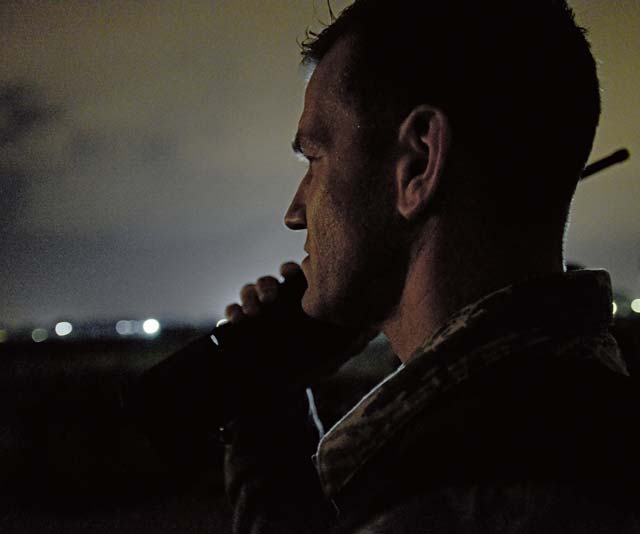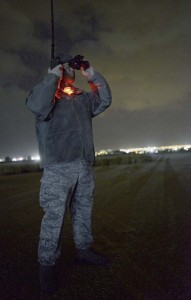
Elefsis, Greece — Airmen from the 435th Air Ground Operations Wing’s Contingency Response Group trained as landing zone safety officers during Stolen Cerberus II Feb. 2 to 14 in Elefsis, Greece.
Stolen Cerberus II is a two-week flying training deployment designed to gauge both aircraft and personnel capabilities as well as improve the interoperability of the Airmen and their Greek counterparts.
Several Airmen received the unique opportunity to practice skills associated with a new landing zone program, which is being piloted by the 435th AGOW.

Tech. Sgt. George Broom, 435th Air Mobility Squadron contingency airfield manager, looks through night vision goggles to monitor a C-130J Super Hercules’ runway approach Feb. 5 in Elefsis, Greece. The 435th Air Ground Operations Wing’s Contingency Response Group is implementing a new landing zone program that will allow CRG members to prepare landing zone operations, from picking the location to actually providing limited air traffic control.
“We don’t get too many training opportunities to work landing zones,” said Tech. Sgt. George Broom, 435th Air Mobility Squadron contingency airfield manager. “This was a great opportunity to come out to Greece and work with the 37th (Airlift Squadron) on foreign soil.”
The new program consists of a three-man team, including an engineer, a landing zone safety officer and an air traffic controller.
“The team would have an engineer to determine if the surface can support the aircraft,” said Maj. James Greathouse, Air Mobility Command air mobility liaison officer assigned to the 21st Theater Sustainment Command.
An airfield manager, who fills the role of landing zone safety officer, ensures the surface remains safe for the aircraft to use. The team’s air traffic controller potentially acts as a landing zone control officer to guide aircraft moving into and out of the air space.
The team ensures there are no obstructions and the surface is free from anything that could damage an aircraft. They also set out daytime or nighttime visual aids to help pilots identify the landing zone.
During the training, the team established 500-foot landing zones that allowed pilots to practice assault landings.
“(During an assault landing) the pilots touch down, get the aircraft to a stop and simulate dumping cargo or offloading passengers as they may do in a tactical situation,” Greathouse said. “Then they get the aircraft back off of the ground and out of the threat zone as quickly as possible.”
Broom said the small teams can set up landing zones for any tactical airlift aircraft. As such, other CRGs are looking to adopt the 435th CRG landing zone program.
“It is a unique program as we are the only CRG worldwide that provides a landing zone program,” Broom said. “We are able to support many different customers across (U.S. Air Forces in Europe and Air Forces Africa).”
The program has the added benefit in that it is also helping to fill a high demand.
“Right now, in terms of the landing zone safety officer program, you’re really looking at a small group of people,” Greathouse said. “The special tactics forces that do it are a limited number in high demand.”
As more Airmen are trained under the landing zone program, they can help free up that demand.
“Through this program, we can train a unit with that contingency response element that can go anywhere in Africa or Europe and survey, open, establish and operate landing zones,” Greathouse said. “It really capitalizes on all of the (Air Force specialty codes) brought into a contingency response group and frees up some of the special tactics group for some of the things they should be doing.”
Though the landing zone program is still getting its roots settled in CRGs, it has already been touted as a success, being recognized as one of USAFE’s top innovations in 2014.


